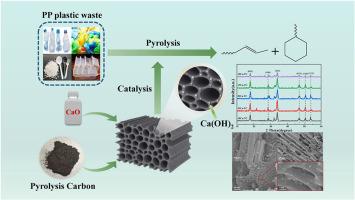High value olefins from polypropylene by in situ catalytic pyrolysis
IF 6.2
2区 工程技术
Q2 ENERGY & FUELS
引用次数: 0
Abstract
The development of low-cost, renewable catalysts for catalyzing the pyrolysis of waste plastics to enable selective upgrading and recycling remains a major challenge. This study reports a novel biochar-loaded calcium-based catalyst that demonstrates excellent olefin selectivity and catalytic efficiency in situ pyrolysis of polypropylene, outperforming traditional catalysts in catalytic performance. The reaction was performed using an in-house developed carbon-based calcium catalyst, which was characterized and examined using a variety of analytical test methods. The effects of catalyst calcium metal loading, feedstock/catalyst ratio and reaction temperature on pyrolysis oil yield and olefin content were investigated. The results showed that olefins and cycloalkanes were the main components of pyrolysis oil in the catalytic pyrolysis experiments, with carbon number distribution between C13 and C25. Under optimal conditions (480 °C, 25 % Ca loading, feedstock/catalyst ratio of 1:0.2), a maximum pyrolysis oil yield of 93.75 % (0.91 g/gpp) was achieved, with an olefin content of 58.87 % (0.55 g/gpp). The high dispersion of Ca2+ species on the porous biochar support was found to synergistically promote C–C bond cleavage while suppressing coke formation via pore confinement and radical stabilization mechanisms. This work offers a promising strategy for the sustainable production of high-quality oils from plastic waste.

聚丙烯原位催化热解制备高值烯烃
开发低成本、可再生的催化剂来催化废塑料的热解,以实现选择性升级和回收仍然是一个重大挑战。本研究报道了一种新型生物炭负载钙基催化剂,该催化剂在聚丙烯原位热解中表现出优异的烯烃选择性和催化效率,在催化性能上优于传统催化剂。该反应使用内部开发的碳基钙催化剂进行,并使用多种分析测试方法对其进行了表征和检查。考察了催化剂金属钙负荷、料媒比和反应温度对热解油收率和烯烃含量的影响。结果表明:在催化热解实验中,裂解油的主要成分为烯烃和环烷烃,碳数分布在C13 ~ C25之间;在最佳条件下(480℃,25% Ca负荷,原料/催化剂比1:0.2),热解油收率为93.75% (0.91 g/gpp),烯烃含量为58.87% (0.55 g/gpp)。研究发现,Ca2+在多孔生物炭载体上的高度分散可以协同促进C-C键的裂解,同时通过孔隙限制和自由基稳定机制抑制焦炭的形成。这项工作为从塑料废物中可持续生产高质量油提供了一个有前途的策略。
本文章由计算机程序翻译,如有差异,请以英文原文为准。
求助全文
约1分钟内获得全文
求助全文
来源期刊

Journal of The Energy Institute
工程技术-能源与燃料
CiteScore
10.60
自引率
5.30%
发文量
166
审稿时长
16 days
期刊介绍:
The Journal of the Energy Institute provides peer reviewed coverage of original high quality research on energy, engineering and technology.The coverage is broad and the main areas of interest include:
Combustion engineering and associated technologies; process heating; power generation; engines and propulsion; emissions and environmental pollution control; clean coal technologies; carbon abatement technologies
Emissions and environmental pollution control; safety and hazards;
Clean coal technologies; carbon abatement technologies, including carbon capture and storage, CCS;
Petroleum engineering and fuel quality, including storage and transport
Alternative energy sources; biomass utilisation and biomass conversion technologies; energy from waste, incineration and recycling
Energy conversion, energy recovery and energy efficiency; space heating, fuel cells, heat pumps and cooling systems
Energy storage
The journal''s coverage reflects changes in energy technology that result from the transition to more efficient energy production and end use together with reduced carbon emission.
 求助内容:
求助内容: 应助结果提醒方式:
应助结果提醒方式:


